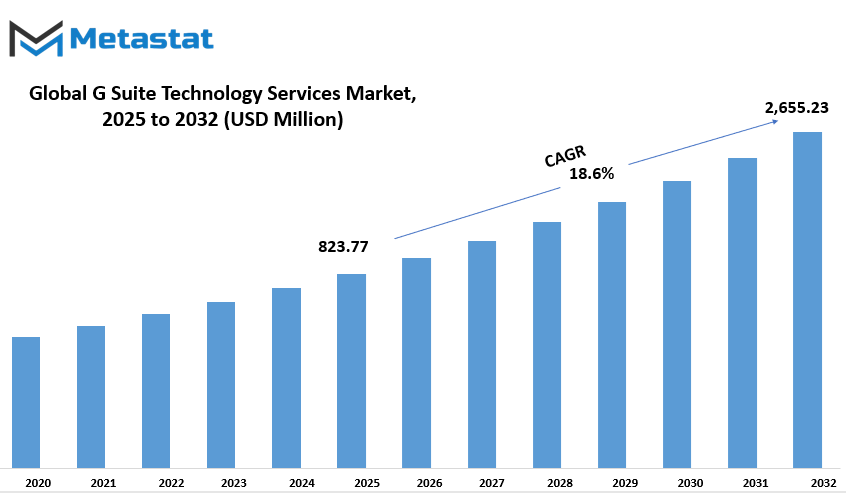MARKET OVERVIEW
The Global G Suite Technology Services market will continue to see dramatic changes as digital transformation strategies are upgraded across industries. This market, rooted in the IT services and cloud-based solutions sector, has moved beyond the days of antiquated deployment and support. Enterprises will no longer be looking for mere setup and migration. Instead, they will require more tailored solutions, greater integration abilities, and securely scalable solutions that correspond to exact operational requirements. As the marketplace evolves, the service providers will be forced to make their approaches more refined with emphasis on innovation and user-centered service delivery to compete.
One of the typical transformations that will shape the Global G Suite Technology Services industry of the future is a transformation away from standardization and toward customization. Businesses will begin to view G Suite not as just a collaboration and communication tool, but as an adaptable framework which accommodates diverse workflows as well as business goals. With growing industry-specific requirements, opportunities will arise in building custom-designed integrations by vendors and fine-tuning productivity applications in verticals such as finance, education, manufacturing, and healthcare. These sectors will demand well-integrated environments offering compliance, dependability, and seamless interoperability with legacy applications.
Data security and governance will also go beyond compliance checkmarks. G Suite technology service-using enterprises will require sophisticated, context-aware controls beyond the defaults. Service providers will have to build proactive monitoring, threat detection, and automated risk mitigation features into their basic offerings. This will remake the competitive dynamics in the Global G Suite Technology Services market in favor of firms that make investments in world-class security infrastructures and can demonstrate measurable protection capabilities.
The second shift will be in how businesses approach user adoption and experience. Businesses will move toward continuous enablement strategies, investing in training models that evolve in parallel with platform changes. The future will see knowledge transfer as a process that spans many months rather than a task of one-time. The market will identify and reward those providers who create human-oriented approaches, incorporating usability enhancements and user feedback loops into service design. This will increase efficiency and ensure that technology is adopted, rather than resisted.
Green deployment and environmental sustainability of cloud offerings will be the top priority in the upcoming years. Companies will opt for those service providers who are aware of green computing philosophies and are willing to be transparent while working with their data handling processes. The Global G Suite Technology Services market will extend its scope to encompass boardroom conversation, where business executives' strategic priorities now begin including assessments of environmental as well as societal impact in addition to performance metrics.
As more and more business functions shift to cloud-first strategies, the market will become a destination where traditional IT outsourcing and modern cloud enablement merge. The providers will be not just technology partners but strategic advisors, guiding businesses through complex digital transformations. This transformation will be a departure from short-term technical support models and propel the Global G Suite Technology Services market towards becoming a long-term strategic platform for businesses across all industries.
Global G Suite Technology Services market is estimated to reach $2,655.23 Million by 2032; growing at a CAGR of 18.6% from 2025 to 2032.

GROWTH FACTORS
The Global G Suite Technology Services market is seeing healthy growth with growing businesses looking for efficient ways to work together online. Among the primary reasons behind the growth is a boost in their requirement for cloud collaboration technologies. Companies wish to possess platforms through which their teams are able to collaborate together in producing, editing, and sharing documents instantly, wherever they are situated. G Suite offers such ease and therefore is a top pick among businesses of all sizes. The second important factor is the rise in remote working. More people are working remotely, and this shift has led companies to adopt solutions like G Suite that provide hassle-free communication and collaboration from various locations.
However, there are some issues hindering the development of the market. One such key issue is data security. With more and more sensitive data being stored and transferred online, organizations are getting apprehensive about how their data is secured. Being compliant with various regulations in various geographies also becomes a problem, particularly for organizations with multiple geographies of operation. These issues may discourage organizations from implementing cloud-based offerings such as G Suite entirely. Another challenge is the high reliance on internet connectivity. Where internet connectivity is unstable or poor, access to G Suite becomes ever more difficult, limiting its usability in some distant or rural areas of the world.
Despite the limitations, there are ample market growth opportunities. One of these areas is expanding G Suite to emerging economies. Developing economies are increasing their digital connectivity, opening the way for G Suite to gain new customers. Such markets have a growing number of small and medium-sized businesses that are starting to employ digital solutions and thus are the optimal candidates for G Suite services. In addition, as G Suite expands, its integration with machine learning and artificial intelligence is extremely promising. AI-enabled features can make users work smarter and quicker, which improves productivity and makes the platform more attractive.
Overall, Global G Suite Technology Services market is being driven by robust demand as well as core challenges. Collapsing collaboration services and work-from-home products are driving demand, while cybersecurity and internet issues are presenting impediments. Even so, new AI features as well as opportunity in emerging markets mean the prognosis for G Suite services is encouraging as more enterprises go digital.
MARKET SEGMENTATION
By Type
The industry is divided into different categories of services based on the kind of support businesses need. Advisory Services constitute a significant segment worth $169.79 million. Advisory Services guide organizations on how to choose the right G Suite tools based on their goals and needs. Migration Services help businesses migrate their current data, emails, and systems to G Suite without data loss or extended downtime. Change Management is all about helping employees and teams adjust to the new systems and tools. This makes the migration to G Suite successful and seamless.
Training & Support are also essential elements of the market. They help employees learn how to use the tools properly, which helps maximize productivity and reduce confusion or technical issues. Integration Services bring G Suite into integration with other systems a business may already be using, so everything can interact more smoothly. There are also specialty services that solve specific or special business needs.
With companies aiming to maximize the way they perform and stay in competition, there will be growing demand for specialist G Suite services. Companies want systems that are simple, effective, and user-friendly. In consideration of that, service providers continue to build on what they already have so that their customers can get the most out of the G Suite platform. The growing importance of data security, flexibility, and collaboration tools is shaping how these services are offered. With workplace trends and technology continuing to evolve, the Global G Suite Technology Services market is likely to continue growing, presenting challenges as well as opportunities for business and service providers.
By Organization Size
Small and Medium Sized Enterprises have been drawn to G Suite because of its simplicity, lower cost, and flexibility. These types of businesses have less IT infrastructure and less budget, and therefore they are interested in using those tools which do not need large technical power and can be easily installed and operated without making large-scale investments. G Suite equips them with email, document sharing, calendar, and collaboration tools all in a single place that streamlines everyday activities and improves collaboration.
As SMEs grow, they can scale their use of G Suite without needing to switch to a completely different system. Such a smooth transition is among the factors that make it possible for most small businesses to stay on the platform when they grow. Large Businesses, however, use G Suite more officially and strategically. They normally have their own separate IT teams and have more complex needs. They take advantage of the fact that G Suite is powerful for handling large volumes of data, for offering custom integrations, and for giving business-class security. For large-scale businesses, shared drives, data loss prevention, and advanced admin controls become important factors for managing hundreds or thousands of users. Though the process of adoption may take more time for large businesses because of the presence of already installed systems and policies at work, the benefits ultimately outweigh the effort to change.
In both cases, G Suite helps businesses work effectively. Whether it is a small group of employees working remotely or a huge corporation managing global operations, the tools promote better communication, easier file sharing, and smoother collaboration. As the market grows even larger, service providers are increasingly looking at understanding the specific needs of each organization size. This helps to offer more personalized support, enhanced onboarding, and ongoing services that meet changing business demands.
Overall, breaking down the Global G Suite Technology Services market based on organization size provides a more detailed understanding of how the tools are utilized and why various companies opt for them. Recognizing these trends makes it easier for service providers and companies to make more intelligent choices that generate more effective outcomes.
By End-Use Industry
The Global G Suite Technology Services market is experiencing increasing demand from various end-use industries. With more and more businesses looking for efficient means of improving communication, data sharing, and productivity, G Suite services are becoming increasingly popular. G Suite services have offerings like Gmail, Google Drive, Docs, Sheets, and Meet that allow teams to work together in real time from anywhere. The demand for cloud-based solutions is increasing day by day, and now companies are coming to understand how G Suite can simplify their daily business processes with all the functions in the cloud.
Retail businesses are using G Suite to automate communication between stores, warehouses, and headquarters. With everything cloud-based, inventory notifications, promotion calendars, and internal messages are simpler to manage. Manufacturing businesses appreciate the real-time collaboration features of G Suite, enabling teams to remain connected across different locations. This is useful when handling supply chains or tracking the status of a project.
In the IT and Telecom sectors, G Suite helps companies to facilitate remote work with strong data security. These sectors handle sensitive customer information and a lot of communication, and G Suite offers easy-to-manage and secure tools. The Healthcare and Life Sciences sector is also turning towards G Suite for better data organization and faster communication among employees. From handling patient records to conducting online meetings, the software offers a more convenient way of handling routine tasks.
Government departments are gradually shifting to cloud platforms like G Suite to reduce paperwork and automate workflow. While the shift is gradual due to compliance and data issues, the benefits of faster communication and shared access are becoming harder to ignore. The BFSI sector implements G Suite to enable communication within and enable teams to respond quickly to customer needs while ensuring compliance requirements.
Educational institutions rely on G Suite to help teachers, students, and administrators learn online. Google Classroom, among other G Suite tools, makes it simple to manage assignments, share files, and stay in touch. For Real Estate and Construction, G Suite helps teams coordinate site maps, manage schedules, and keep clients updated, even when working remotely. Other industries are also finding ways to take advantage of G Suite's flexible tools to make their work more efficient and get it linked. The more companies realize the value of effortless collaboration and easy information access, the more the market for G Suite will keep growing in all sectors.
|
Forecast Period |
2025-2032 |
|
Market Size in 2025 |
$823.77 million |
|
Market Size by 2032 |
$2,655.23 Million |
|
Growth Rate from 2025 to 2032 |
18.6% |
|
Base Year |
2024 |
|
Regions Covered |
North America, Europe, Asia-Pacific, South America, Middle East & Africa |
REGIONAL ANALYSIS
The Global G Suite Technology Services market is segmented based on different regions along with their respective demand and growth rate. The market is segmented geographically into North America, Europe, Asia-Pacific, South America, and the Middle East & Africa. North America includes the United States, Canada, and Mexico. This region has recorded rapid growth in the adoption of G Suite services due to the high concentration of large companies, investment in cloud infrastructure and the increased focus on improving workplace productivity with digital tools. The United States remains the dominant contributor, followed by Canada, while Mexico is gradually expanding its digital presence with growing interest in cloud solutions from small and mid-size enterprises.
The market in Europe is spread across the UK, Germany, France, Italy, and the rest of Europe. Germany and the UK are leading in this region with widespread adoption of G Suite services across industries. The growing requirement for remote working solutions and data security is making organizations shift to cloud platforms. France and Italy are also growing steadily, mostly among startups and schools. Though some countries in the rest of Europe are also catching up, the overall trend suggests a positive direction with growing inclination to invest in digital ways.
Asia-Pacific, comprising India, China, Japan, South Korea, and other countries in the region, is becoming one of the fastest-growing markets. India and China, for instance, have high counts of medium and small-scale businesses seeking to utilize G Suite services to augment productivity and collaboration. Japan and South Korea also possess well-developed tech infrastructure that facilitates the expansion of such services. The region is graced with a technologically knowledgeable population and an increasing government policy favoring technology adoption, so it is set to become a future growth point.
South America includes Brazil, Argentina, and surrounding countries. While the size of the market is smaller in this region as opposed to Asia-Pacific or North America, there is steady progress. Brazil, particularly, is turning into a cloud leader for the region. Finally, the Middle East & Africa region, such as GCC countries, Egypt, South Africa, and so forth, also expresses interest in using G Suite services to facilitate business growth and organize operations. Although expansion comes more slowly, increasing awareness and expenditure on cloud technology is likely to further propel the market.

COMPETITIVE PLAYERS
The Global G Suite Technology Services market is growing consistently with rising demand for cloud-based collaboration platforms and digital transformation. Organizations these days are looking more seriously towards remote working and streamlined communication, and G Suite services provide precisely that. G Suite services consist of software products that allow file sharing, instant collaboration, video meetings, and safe cloud storage, all allowing teams to function more efficiently anywhere in the world. As businesses mature to adopt these new ways of working, the demand for scalable and trustworthy solutions continues to increase.
Some of the key players in the G Suite Technology Services market are Google, SADA Systems, Cloudypedia, Zoho Corporation, Salesforce, Bespin Global, Box, Slack Technologies, Smartsheet, Asana, and Trello (Atlassian). Such players are dynamically influencing the market through the delivery of tailor-made solutions that address the particular needs of different businesses. They design solutions that increase productivity, reduce labor at hand, and enhance the management of information as well as workflow. Google, which is the leading vendor of G Suite, has a large market lead, while others like SADA Systems and Cloudypedia implement and provide support with dedicated services for making clients better use the tools.
The market is also seeing growing adoption of G Suite solutions by small and medium-sized companies. This is partly due to the fact that these tools are inexpensive, simple to utilize, and provide scalable solutions that expand with a company. Cloud-based services also minimize the necessity for extensive IT infrastructures, making them attractive to firms wanting to save on expenses while remaining efficient. Collaboration and communication tools like Slack, Trello, and Asana are increasingly being integrated into daily routines, allowing teams to track progress, set objectives, and share updates in real time.
Data security and privacy are also major concerns that the market is addressing. With increasing data being stored and transmitted online, service providers are prioritizing their security systems. Encryption, user access control, and regular security updates have become the norm now in these devices. Customers are looking for service providers that not only offer convenience but also are ensuring data security.
With businesses relying more and more on digital solutions, the Global G Suite Technology Services market should grow. The demand for best-in-class services will further drive the major players to innovate their offerings, simplify them, make them safer, and more efficient, so that businesses can stay connected, productive, and competitive.
G Suite Technology Services Market Key Segments:
By Type
- Advisory Services
- Migration Services
- Change Management
- Training & Support
- Integration Services
- Other
By Organization Size
- Small & Medium Enterprises
- Large Enterprises
By End-Use Industry
- Retail
- Manufacturing
- IT & Telecom
- Healthcare & Life Sciences
- Government
- BFSI
- Education
- Real Estate & Construction
- Other
Key Global G Suite Technology Services Industry Players
- SADA Systems
- Cloudypedia
- Zoho Corporation
- Salesforce
- Bespin Global
- Box
- Slack Technologies
- Smartsheet
- Asana
- Trello (Atlassian)
WHAT REPORT PROVIDES
- Full in-depth analysis of the parent Industry
- Important changes in market and its dynamics
- Segmentation details of the market
- Former, on-going, and projected market analysis in terms of volume and value
- Assessment of niche industry developments
- Market share analysis
- Key strategies of major players
- Emerging segments and regional growth potential








 US: +1 3023308252
US: +1 3023308252






